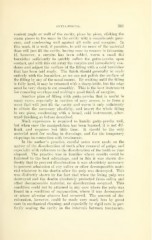Page 703 - My FlipBook
P. 703
GUTTA-PERCHA. 361
venient angle or wall of the cavity, piece by piece, sticking the
warm pieces to the mass in the cavity with a consideral)le pres-
sure, and condensing well against all walls and margins. In
this work, it is well, if possible, to add no more of the material
than will just fill the cavity, having none to remove in trinnning.
If, however, a surplus has been added, warm a small fiat
burnisher sufficiently to quickly soften the giatta-percha upon
contact, and with this cut away the sur))lus and immediately con-
dense and adjust the surface of the filling with a cold burnisher
that has been laid ready. The finish should generally be made
entirely with the burnisher, as we can not polish the surface of
the filling by any of the usual means. By waiting until the filling
is fully hard, it may be trimmed with a sharp knife, but the edge
must be veiy sharp to cut smoothly. This is the best instrument
for removing overlaps and making a good finish of margins.
Another plan of filling with gutta-percha that is useful in
many cases, especially in cavities of easy access, is to form a
mass that will just fill the cavity and warm it only sufficiently
to obtain the necessary plasticity, and insert the whole filling
in one piece, condensing with a broad, cold instrument, after-
ward finishing as before described.
Much experience is required to handle gutta-percha well,
but when once the manipiilation has been learned, it is not dif-
ficult, and requires but little time. It should be the only
material used for sealing in dressings, and for the temporary
stopi^ings in connection with treatments.
In the author's practice, careful notes were made on the
matter of the discoloration of teeth after removal of pulps, and
especially with reference to the discoloration of the teeth as time
elapsed. The practice was in families where results could be
followed to the best advantage, and in this it was shown dis-
tinctly that to prevent discoloration it was absolutely necessary
to prevent admission of any saliva or other decomposable mate-
rial whatever to the dentin after the pulp was destroyed. This
was distinctly shown by the fact that when the living pulp was
destroyed and the dentin absolutely protected from saliva and
other decomposable material, no discoloration occurred. This
condition could not be attained in any case where the pulp was
found in a condition of suppuration, where it was decomposed
or where alveolar abscess had occurred. The amount of dis-
coloration, however, could be made very much less by great
care in mechanical cleaning, and especially by rigid care in per-
fectly sealing the cavity in the intervals between treatments.


